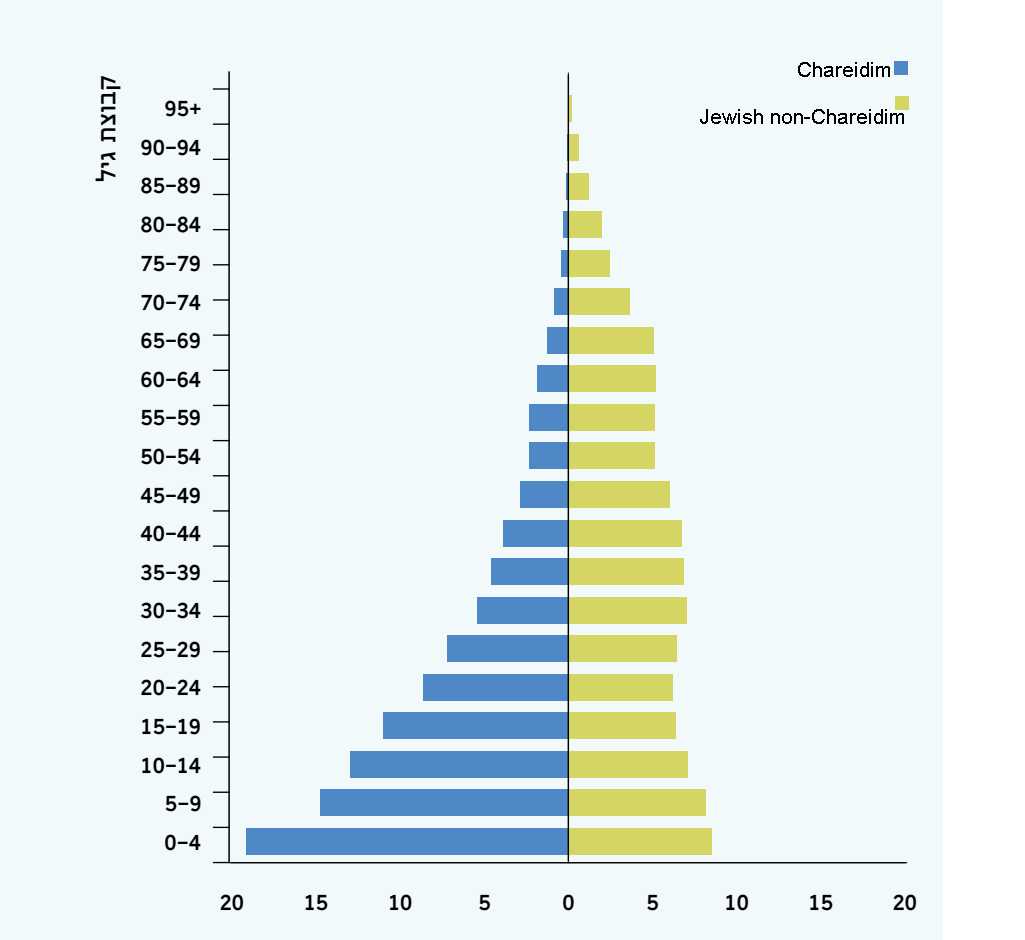Population
This year, the chareidi population in Israel reached the million mark, which makes it 12% of the general Israeli population (including Arabs). By year 2030 this sector is expected to reach 16% of the overall Israeli population and by 2065 it will represent one third of the Israeli society and 40% of the Jewish population.
The breakdown by age for chareidim and non-chareidim

The chareidim are a young community. 58% of chareidim are between 0-19 years of age as compared to 30% of the general Jewish population. Nevertheless, from 2005 there has been a decrease in the birth rate of chareidi women. In 2003 the average number of children per chareidi women was 7.5, but today it stands at 6.9, as compared to 2.4 of non-chareidi Jewish women.
Family Status
The married percentage in the adult chareidi population above twenty is 82% as compared to 63% by the general population. In this area there has been a noticeable rise in the age of marriages. Whereas in 2005, 61% of chareidim aged 20-24 were married, today only 44% of chareidim between the ages of 20-24 are married.
While in 2005, 76% of chareidim in age range of 20-29 were married, in 2016 only 67.5% are married. Correspondingly, the number of married women between ages 20-29 was 80%, but in 2016 the number has fallen to 67%. A corresponding though lesser drop is found by men from 71% to 68%.
Education
Some 300,000 chareidi children are enrolled in the chareidi educational system, constituting 18% of the general student population in Israel. The growth rate has dropped by a quarter between 2013 and 2016 from 4.2% to 3.2% per year. This is compared to a rise of the growth of the government school system of 0.5% per year to 2.3% annually. Two explanations can be suggested for this phenomenon: the drop in the chareidi birth rate and a drop in the marked attractiveness of chareidi schools as compared to that of the general government schools.
Between the years 1999 and 2014 the numbers of bnei yeshiva and avreichim grew by 4% a year. However when the chareidi political parties were not in the government, their number dropped by 16%, probably as a result of the lowering of the exemption age from the army and a cut in government yeshiva support. In 2016, the number of yeshiva students and avreichim rose by 4%.
About two thirds of the income of a typical chareidi family comes from employment. The figure in the general Israeli population is 78%. An average chareidi family spends NIS 13,676 per month, which is about 15% lower than the non-chareidi family, and on a per capita basis even lower since the chareidi families are larger.
Of the overall chareidi population, 42% have a driver's license, but only 29% of the women have one. (Bais Yaakov teachers are not allowed to drive.) 41% of chareidi households own a car, compared to 79% of all households. Overall, 73% of the women hold a job, and 52% of the men.




